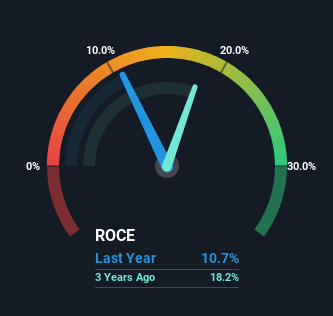- United States
- /
- Specialty Stores
- /
- NasdaqGS:ARHS
Arhaus' (NASDAQ:ARHS) Returns On Capital Not Reflecting Well On The Business

Did you know there are some financial metrics that can provide clues of a potential multi-bagger? Ideally, a business will show two trends; firstly a growing return on capital employed (ROCE) and secondly, an increasing amount of capital employed. Basically this means that a company has profitable initiatives that it can continue to reinvest in, which is a trait of a compounding machine. In light of that, when we looked at Arhaus (NASDAQ:ARHS) and its ROCE trend, we weren't exactly thrilled.
Understanding Return On Capital Employed (ROCE)
For those who don't know, ROCE is a measure of a company's yearly pre-tax profit (its return), relative to the capital employed in the business. Analysts use this formula to calculate it for Arhaus:
Return on Capital Employed = Earnings Before Interest and Tax (EBIT) ÷ (Total Assets - Current Liabilities)
0.11 = US$86m ÷ (US$1.2b - US$402m) (Based on the trailing twelve months to December 2024).
So, Arhaus has an ROCE of 11%. In absolute terms, that's a pretty normal return, and it's somewhat close to the Specialty Retail industry average of 13%.
See our latest analysis for Arhaus

In the above chart we have measured Arhaus' prior ROCE against its prior performance, but the future is arguably more important. If you're interested, you can view the analysts predictions in our free analyst report for Arhaus .
The Trend Of ROCE
In terms of Arhaus' historical ROCE movements, the trend isn't fantastic. Over the last five years, returns on capital have decreased to 11% from 21% five years ago. Meanwhile, the business is utilizing more capital but this hasn't moved the needle much in terms of sales in the past 12 months, so this could reflect longer term investments. It's worth keeping an eye on the company's earnings from here on to see if these investments do end up contributing to the bottom line.
On a side note, Arhaus has done well to pay down its current liabilities to 33% of total assets. That could partly explain why the ROCE has dropped. Effectively this means their suppliers or short-term creditors are funding less of the business, which reduces some elements of risk. Some would claim this reduces the business' efficiency at generating ROCE since it is now funding more of the operations with its own money.
The Bottom Line
To conclude, we've found that Arhaus is reinvesting in the business, but returns have been falling. Unsurprisingly, the stock has only gained 16% over the last three years, which potentially indicates that investors are accounting for this going forward. Therefore, if you're looking for a multi-bagger, we'd propose looking at other options.
Arhaus does have some risks, we noticed 3 warning signs (and 1 which is significant) we think you should know about.
While Arhaus isn't earning the highest return, check out this free list of companies that are earning high returns on equity with solid balance sheets.
New: Manage All Your Stock Portfolios in One Place
We've created the ultimate portfolio companion for stock investors, and it's free.
• Connect an unlimited number of Portfolios and see your total in one currency
• Be alerted to new Warning Signs or Risks via email or mobile
• Track the Fair Value of your stocks
Have feedback on this article? Concerned about the content? Get in touch with us directly. Alternatively, email editorial-team (at) simplywallst.com.
This article by Simply Wall St is general in nature. We provide commentary based on historical data and analyst forecasts only using an unbiased methodology and our articles are not intended to be financial advice. It does not constitute a recommendation to buy or sell any stock, and does not take account of your objectives, or your financial situation. We aim to bring you long-term focused analysis driven by fundamental data. Note that our analysis may not factor in the latest price-sensitive company announcements or qualitative material. Simply Wall St has no position in any stocks mentioned.
About NasdaqGS:ARHS
Arhaus
Operates as a lifestyle brand and premium retailer in the home furnishings market in the United States.
Flawless balance sheet and fair value.
Similar Companies
Market Insights
Community Narratives


